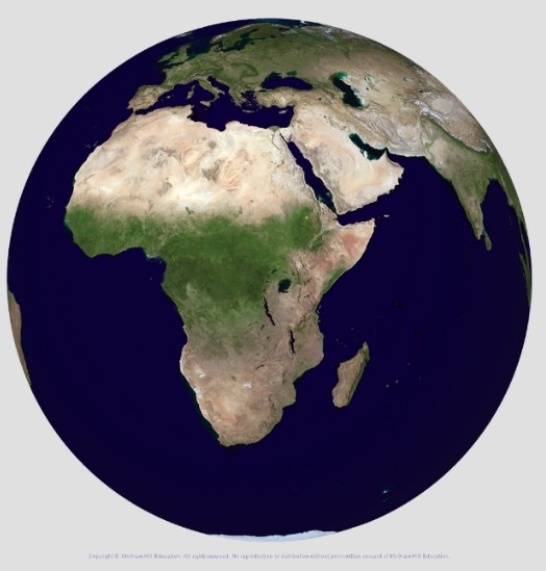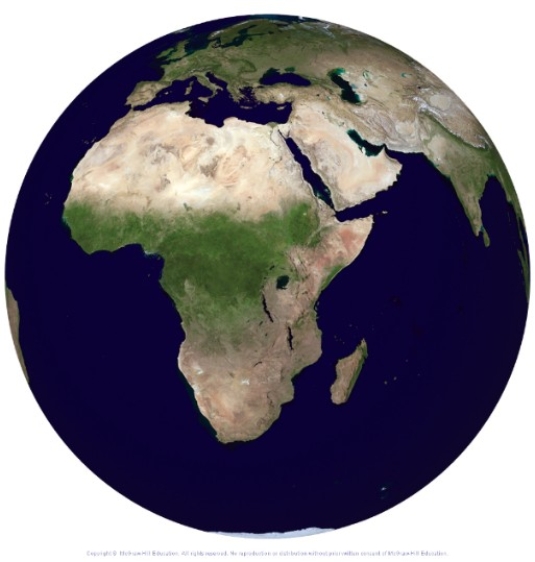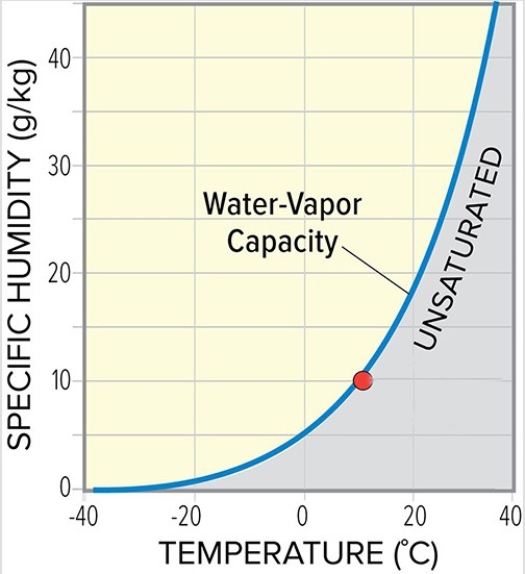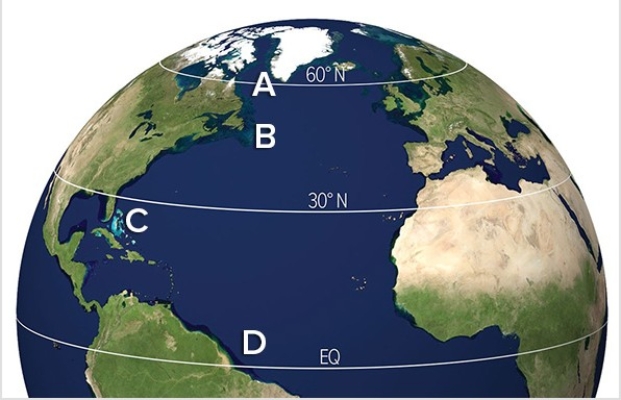A) snow passing through a fairly thick layer of above-freezing air before passing through a thin layer of subfreezing temperatures near the surface.
B) air temperatures decreasing uniformly with height,producing the cold conditions necessary for freezing rain formation.
C) air temperatures increasing uniformly with height,producing the cold conditions necessary for freezing rain formation.
D) snow passing through a fairly thin layer of above-freezing air before passing through a thick layer of subfreezing temperatures near the surface.
F) All of the above
Correct Answer

verified
Correct Answer
verified
Multiple Choice
The warm air being lifted in this map is mostly located in the ________ portion of the map. 
A) northern
B) southern
C) eastern
D) western
F) A) and D)
Correct Answer

verified
Correct Answer
verified
Multiple Choice
The formation of sleet involves
A) snow passing through a layer of freezing air forming a glaze of ice when reaching the surface.
B) air temperatures decreasing uniformly with height,producing the cold conditions necessary for freezing rain formation.
C) air temperatures increasing uniformly with height,producing the cold conditions necessary for freezing rain formation.
D) snow passing through a layer of above-freezing air,melting,and then refreezing,forming a pellet that bounces when reaching the surface.
F) A) and B)
Correct Answer

verified
Correct Answer
verified
Multiple Choice
This globe from the atmospheric moisture investigation shows land cover,with green being vegetation and tan and brown being bare rock and sand.The largest green areas on the land-cover globe (they are dark on a black and white version) correlate most clearly with which aspect? 
A) Location of prevailing westerlies
B) Areas with ice much of the year
C) High amounts of precipitation
D) Rain shadows
F) A) and D)
Correct Answer

verified
Correct Answer
verified
Multiple Choice
Drought would be more likely with
A) location next to a warm ocean current.
B) persistent onshore breeze.
C) persistent low pressure.
D) persistent offshore breeze.
F) B) and C)
Correct Answer

verified
Correct Answer
verified
Multiple Choice
Fog in the United States is least likely to occur in the ________ when vapor pressure is higher and temperatures are ________
A) winter; lower
B) winter; higher
C) summer; higher
D) summer; lower
F) B) and D)
Correct Answer

verified
Correct Answer
verified
Multiple Choice
The rate at which saturated air cools with adiabatic ascent is
A) 10°C/km.
B) 8.3°C/km.
C) 3.3°C/km.
D) variable depending on temperature.
F) B) and C)
Correct Answer

verified
Correct Answer
verified
Multiple Choice
A parcel of with a specific humidity of 20 g water vapor/kg air at 20°C is heated to 30°C.Which of the following is true?
A) Water-holding capacity will decrease.
B) Specific humidity will decrease.
C) Relative humidity will decrease.
E) None of the above
Correct Answer

verified
Correct Answer
verified
Multiple Choice
The east coasts of midlatitude continents are generally
A) dry because of the rain shadow effect on the lee of mountains plus cold,dense air,produces a sinking motion.
B) moderately wet,as cold and warm air meet frequently,producing frontal precipitation.
C) moderately dry due to the sinking motion of stable subtropical high pressure cell.
D) generally wet because of the shift in the Intertropical Convergence Zone produces unstable conditions.
F) C) and D)
Correct Answer

verified
Correct Answer
verified
Multiple Choice
The frontal lifting pictured on this map is moving to the 
A) north.
B) south.
C) east.
D) west.
F) A) and D)
Correct Answer

verified
Correct Answer
verified
Multiple Choice
This globe from the atmospheric moisture investigation shows land cover,with green being vegetation and tan and brown being bare rock and sand.The areas with the least vegetation (they are light on a black and white version) correlate most clearly with which aspect? 
A) Location of the trade winds
B) Location of the ITCZ
C) Excessive amounts of precipitation
D) Low specific humidity,water vapor,and precipitation
F) A) and B)
Correct Answer

verified
Correct Answer
verified
Multiple Choice
A parcel of saturated air at 10°C with 10 g water vapor/kg of air is heated to 20°C.Which of the following is true? 
A) The air has 10 g water vapor/kg of air and is now unsaturated.
B) The air has 10 g water vapor/kg of air and is still saturated.
C) The air has 20 g water vapor/kg of air and is now unsaturated.
D) The air has 20 g water vapor/kg of air and is now saturated.
F) A) and C)
Correct Answer

verified
Correct Answer
verified
Multiple Choice
The molecular structure of water has an asymmetrical arrangement of hydrogen atoms,causing
A) the hydrogen side of the water molecule to have a positive charge.
B) the hydrogen side of the water molecule to have a negative charge.
C) the oxygen side of the water molecule to have a positive charge.
D) the overall charge of the water molecule to be neutral.
F) All of the above
Correct Answer

verified
Correct Answer
verified
Multiple Choice
Clouds are classified on the basis of all of these factors except
A) dew point.
B) form.
C) altitude.
D) whether the cloud is raining.
F) All of the above
Correct Answer

verified
Correct Answer
verified
Multiple Choice
The specific humidity of air changes when there is a change in
A) pressure of a parcel of air.
B) the temperature of a parcel of air.
C) the addition or removal of water vapor.
D) all of these.
F) A) and D)
Correct Answer

verified
Correct Answer
verified
Multiple Choice
All of the following is true concerning freezing rain hazards except freezing rain
A) bounces when hitting the ground,coating the streets with a slick layer of ice.
B) causes more death and damage per hour than any other storm.
C) weighs trees and power lines to the breaking point.
D) is difficult to discern in a car because defrosters prevent freezing that might alert a driver to the hazard.
F) C) and D)
Correct Answer

verified
Correct Answer
verified
Multiple Choice
Which of the following locations would have the highest specific humidity? 
A) A
B) B
C) C
D) D
F) B) and C)
Correct Answer

verified
Correct Answer
verified
Multiple Choice
The abundance of cloudy days in January on the East Coast,particularly the Northeast can be explained by
A) dew point temperatures equaling relative humidity values.
B) dew point temperatures being much below air temperature.
C) dew point temperatures much greater than air temperature.
D) dew point temperatures not being far below air temperature.
F) A) and B)
Correct Answer

verified
Correct Answer
verified
Multiple Choice
Which of the following locations would have the lowest January precipitation totals as a result of the air's low water vapor capacity? 
A) A
B) B
C) C
D) D
F) C) and D)
Correct Answer

verified
Correct Answer
verified
Multiple Choice
Given the prevailing wind direction indicated by the arrow,where would you expect temperatures to be warmest and the humidity lowest? 
A) A
B) B
C) C
D) D
F) A) and D)
Correct Answer

verified
Correct Answer
verified
Showing 61 - 80 of 85
Related Exams